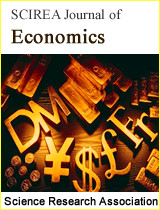Food Wastage, Poverty and Economic Growth
DOI: 10.54647/economics79265 67 Downloads 2744 Views
Author(s)
Abstract
This paper attempts to identify the impact of food wastage on economic growth using the data for 165 countries over the 2014-2018 period. With the help of ordinary least squares (OLS) and generalized linear model (GLM), the study shows that food wastage and poverty impact GDP growth negatively. Poverty and food wastage are positively related. Reducing food wastage can lead to poverty reduction, and that can stimulate GDP growth. Take measures to reduce food wastage, especially in middle-income countries where the undernourishment rate is high. Reduce food wastage in various stages of production, distribution, and transporting with innovative technology.
Keywords
Poverty, food, wastage, growth, glm
Cite this paper
Jayadevan CM,
Food Wastage, Poverty and Economic Growth
, SCIREA Journal of Economics.
Volume 6, Issue 5, October 2021 | PP. 114-123.
10.54647/economics79265
References
| [ 1 ] | Aghion, P., & Howitt, P. (1992). A Model of Growth Through Creative Destruction. A Model of Growth Through Creative Destruction, 60(2). |
| [ 2 ] | Barro, R. J. (1996). Determinants Of Economic Growth: A Cross-Country Empirical Study. Massachusetts Avenue. |
| [ 3 ] | Barro, R. J. (1996). Determinants of Economic Growth: A cross-country empirical study. NBER WORKING PAPER SERIES. |
| [ 4 ] | Barro, R. J. (2003). Determinants of Economic Growth in a Panel of Countries. ANNALS OF ECONOMICS AND FINANCE 4, 231–274. |
| [ 5 ] | Burnside, C., & Dollar, D. (2000). Aid, Policies, and Growth. The American Economic Review, 90(4), 847-868. |
| [ 6 ] | Dollar, D. (1992). Outward-Oriented Developing Economies Do Grow More Rapidly: Evidence from 95 LDCs, 1976-1985. Economic Development and Cultural Change, 40(3), 523-544. |
| [ 7 ] | FAO(2019), http://www.fao.org/sustainable-development-goals/indicators/211/en/ FAO (2021), http://www.fao.org/faostat/en/#data/QC |
| [ 8 ] | Howitt, P., & Aghion, P. (1992). A Model of Growth Through Creative Destruction. Econometrica, 60(2), 323- 351. |
| [ 9 ] | Lucas, J., Robert E. (1988). On The Mechanics Of Economic Development. Journal of Monetary Economics, 22, 3-42. |
| [ 10 ] | Mankiw, N. G., Romer, D., & Weil, D. N. (1992). A Contribution to the Empirics of Economic Growth. The Quarterly Journal of Economics, 107(2). |
| [ 11 ] | Read moral-Benito, E. (2009). Determinants of Economic Growth A Bayesian Panel Data Approach. Policy ReseaRch WoRking PaPeR, 4830. |
| [ 12 ] | Reed, W. R. (2009). The determinants of U.S. state economic growth: A less extreme Bound Analysis. Economic Enquiry, 47(4), 685-700. |
| [ 13 ] | Romer, P. M. (1986). Increasing Returns and Long-Run Growth. Journal of Political Economy, 94(5), 1002- 1037. |
| [ 14 ] | Romer, P. M. (1990). Endogenous Technological Change. Journal of Political Economy, 98(5), S71 - S102. Sachs, J. D., & Warner, A. M. (1997). Fundamental Sources of Long-Run Growth. The American economic review, 87(2). |
| [ 15 ] | Snowdon, B., & Vane, H. R. (Eds.). (2005). Modern Macroeconomics: Its origins, development and current state. Northampton, Massachusetts.: Elgar, Edward |
| [ 16 ] | Solow, R. M. (1956). A Contribution to the Theory of Economic Growth. The Quarterly Journal of Economics, 70(1).https://en.wikipedia.org/wiki/List_of_countries_by_GDP_(PPP)_per_capita. |

